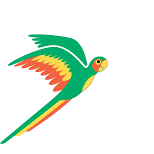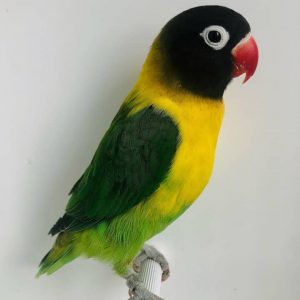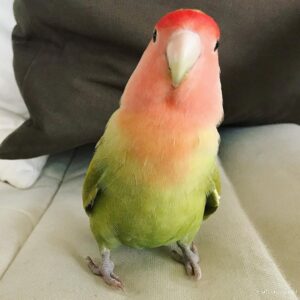Lovebirds For Sale
Lovebirds For Sale
Lovebirds for sale,lovebirds are active, cheerful and beautifully decorative. These petite ‘pocket’ parrots are very intriguing! Lovebirds come from the drier regions of Africa. Because they evolved from a very harsh environment, they are very suited to captivity. Not only do they have a good disposition, these charming, brilliantly colored little pets are very hardy and easy to care for. They can also provide you with a successful breeding experience.
In the wild lovebirds live in flocks. They will often bond with a mate for life and show fierce loyalty and affection to their family. If you can earn there affections as young birds, you will receive that same fierce loyalty from your little friends. They are very social with both their keepers and their mate.
Care and feeding of our lovebirds for sale
Bird Food
Foods available for Lovebirds include formulated diets, either pelleted or extruded, seed only diets, and small parrot mixes which offer a mixture of both. There are pros and cons to feeding only a formulated diet as well as feeding only a seed diet.
Formulated Diet:
A formulated diet provides a good nutritional base so does not require the addition of vitamins. However it does not contain the phytonutrients (antioxidant pigments) that are found in vegetables, fruits, grains, and seeds. Also, parrots can become bored with formulated diet due to the lack of variety.
Seed Diet:
A seed only diet offers much more variety but requires additional vitamin and calcium supplements. Lovebirds need not only nutritional requirements met but also variety for psychological enrichment.
A lovebirds’s diet will consist of 1 1/2 to 2 ounces (45-60 grams) of feed daily for a single bird.
Supplements
Supplements include fresh vegetables, greens, tree branches for the bark, some fruits, and millet spray. Some of the fruit supplements include berries, apples, grapes, pears, bananas, and kiwi. Some of the greens and vegetable supplements include spinach, endive, watercress, chickweed, radish, parsley, dandelions, carrot tops, corn on the cob, peas, endive, field lettuce, and various garden herbs.
Water
Lovebirds drink a lot of water, so will need fresh drinking water every day.
Bird Baths
Most lovebirds love a bath either in a flat earthenware dish or by spraying them with a light mist of lukewarm water. If you use a bathing dish, you will see the birds perch on the edge and dip their heads and upper bodies in the water and beating their wings. They prefer this kind of bath to getting into the water.
Bird Grooming
Lovebirds for sale generally maintain their nails and beaks on their own through climbing and chewing. Another good use they make of their tree branches.wing. Another good use they make of their tree branches.
Social Behaviors of lovebirds
Lovebirds as pets, as well as in the wild, are very social birds. Generally and in most situations, it is thought to be essential for their good health and happiness that they be kept in pairs, not singly. If keeping a single lovebird, you must provide the necessary social interaction that it is missing from another bird. These birds develop fierce loyalties to their keeper or their mate.
Aside from their social nature toward you or their mate, lovebirds can be extremely aggressive towards other birds. You must be certain that all pairs get along together, and that they are true “pairs”, not mismatched. Bonded pairs constantly groom each other and will feed each other from the crop during breeding season and all year round.
These little birds will chatter all day long. They will hide in their nest box if they are startled by a sudden noise, if they spot a potential predator, or if it gets cold and windy.
Speech & Sound
Lovebirds are a chatty bunch, singing and whistling all day long. Lovebirds are especially vocal at dawn and dusk.
With all that vocalizing, you might think that lovebirds talk. Well, lovebirds usually do not talk in the way you expect.
Temperament
Lovebirds are active, curious, feisty, and playful, and they pack a lot of personality into a small package. They are very social birds that form strong bonds with their owners and can become very cuddly as a result.
If not properly tamed and worked with from a young age, lovebirds can become very territorial, aggressive, and jealous. Female lovebirds, according to some experts, are more prone to jealousy and territoriality than males, but birds of both sexes can have wonderful personalities.
Lovebirds, while not as loud as some larger parrots, can still produce a loud, high-pitched screech, especially when they want your attention.
Activities of Lovebirds
Lovebirds awaken with the dawn, get a drink, eat, and then immediately begin to chirp. They will generally quiet down by mid-morning and resume their chirping in the late afternoon.
These birds are very active, flying and climbing about, gnawing on wood or chew toys, and grooming themselves many times all day. They love toys of all kinds such as seed bells, swings, ladders, mirrors, shiny objects, and wooden gnaws. A lovebird outside of it’s cage will not stay on it’s playpen, they like to explore. Be sure this room is safe with no open doors or windows, no toxic plants, no open water containers, and no hot stove.
Colors and Markings
Lovebirds are known for their short and rather blunt tail feathers. Beyond size, this is one of the primary features that distinguish them from budgerigars. Lovebirds also have a stockier build.
The colors that these species come in can vary widely from peach to teal to white to green. They all tend to be rather vivid with heads and faces of a different color than the main body feathers. Many of the popular pet lovebirds have mostly green plumage.
Showing all 2 results
-
$200.00 – $400.00
-
$200.00 – $450.00


